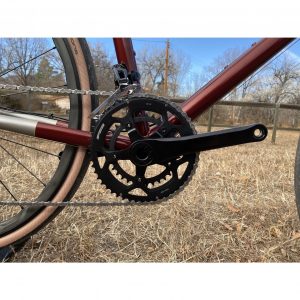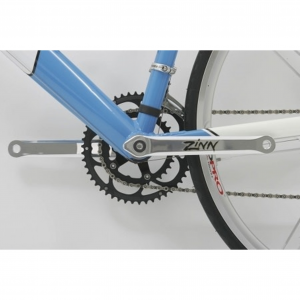The Case for Short Cranks
By Lennard Zinn
It’s probably clear in my previous “Why Proportional-Length Cranks?” blog post that I generally see performance benefits for tall riders with long legs in using long cranks. And by long, I mean longer than the standard 170-175mm (or even 165-180mm) offerings from the big component brands. In fact, I have found that riders will generally climb best (and often feel best) on cranks that are in the range of 20-21.6% of their inner leg length.
 That said, there are some applications that offer clear performance reasons for long-legged riders to use standard crank lengths (and for shorter riders to use shorter-than-standard cranks). Riding individual events against the clock (road time trials and timed velodrome events), bikes with aero handlebars, solo riding on flat and rolling terrain, as well as in triathlons in which drafting is not allowed are just a few. This same advantage applies for the same reason with shorter riders for whom standard crank lengths work well when climbing to use extra short cranks (shorter than 165mm) when competing in events with aero bars.
That said, there are some applications that offer clear performance reasons for long-legged riders to use standard crank lengths (and for shorter riders to use shorter-than-standard cranks). Riding individual events against the clock (road time trials and timed velodrome events), bikes with aero handlebars, solo riding on flat and rolling terrain, as well as in triathlons in which drafting is not allowed are just a few. This same advantage applies for the same reason with shorter riders for whom standard crank lengths work well when climbing to use extra short cranks (shorter than 165mm) when competing in events with aero bars.
The reason for this is that, beyond 12 mph, aerodynamic drag is the biggest resistance force the rider must overcome. Since the bulk of the aerodynamic drag of the bike and rider is created by the rider’s body, the higher the speed, the more important is the body shape. The fastest body shape is low, flat, and narrow. Shorter cranks may help the road bike rider achieve a better fit on the bike and allow them to get a lower position. Which crankset do I need? It requires a bit more in-depth thought from both the rider and bike fitter.
Crank Length with Aero Bars
 Some impediments to getting the rider’s back into a horizontal position are: the knees coming up and hitting the belly and/or the chest, the hip joint becoming impinged from being folded into such a tight angle, and the low back and hamstrings being overly stretched. Triathlon bikes traditionally counteract this with dramatically forward saddle positions so that the feet are further back relative to the hips, thus opening up the hip angle.
Some impediments to getting the rider’s back into a horizontal position are: the knees coming up and hitting the belly and/or the chest, the hip joint becoming impinged from being folded into such a tight angle, and the low back and hamstrings being overly stretched. Triathlon bikes traditionally counteract this with dramatically forward saddle positions so that the feet are further back relative to the hips, thus opening up the hip angle.
The International Cycling Union restricts how far forward the saddle can be ahead of the cranks. This, however, is not allowed on a road time trial bike, because the International Cycling Union restricts how far forward the saddle can be ahead of the cranks. Shorter cranks allow the upper body to get closer to horizontal in this case.
While tall riders could produce incrementally more power by using longer rather than short cranks that are better matched to their legs from the perspectives of leverage, muscle extension/contraction, and knee angles, this power output increase can be more than offset by increased aerodynamic drag. If the handlebars have to come up higher to prevent the knees from hitting the chest, the hips from impingement, and the low back and hamstrings from strain, then the upper body is going to be pushing more air ahead of it. It often takes more power to overcome this than was gained by using longer over shorter cranks. Road bike riders may choose to use short cranks to allow the upper body to get closer to horizontal as a solution.
Which Crankset Do I Need?
 Tour de France results have consistently shown that using a crank that is 20-21% as long as the inner leg length works well overall. In the case of time trials, that proportion could be reduced to 18-19% to maximize riding speed. This results in a reduction in crank length of around 15-20 mm from climbing crank length to time trial crank length. With short cranks, the rider’s knees thus come up 30-40 mm lower at the top, so the handlebars can come down that same 30-40mm, which can make a big difference aerodynamically on a road bike.
Tour de France results have consistently shown that using a crank that is 20-21% as long as the inner leg length works well overall. In the case of time trials, that proportion could be reduced to 18-19% to maximize riding speed. This results in a reduction in crank length of around 15-20 mm from climbing crank length to time trial crank length. With short cranks, the rider’s knees thus come up 30-40 mm lower at the top, so the handlebars can come down that same 30-40mm, which can make a big difference aerodynamically on a road bike.
Shorter cranks can help in mass-start professional road racing, where the tallest riders often have the job of being lead-out men for their team’s sprinters. While not using aero bars in this situation, the lead riders have to get as low as possible on the bike, because reducing aerodynamic drag is supercritical when leading out a sprinter at the front of the peloton in the last few kilometers, when the sustained speed can approach 80 kph (50 mph).
A good example of this is Mario Scirea, whose 194 cm (over 6’4”) height was rare in the pro peloton. Shorter cranks on his road bike helped him lead out super sprinter Mario Cipollini — his main task for a good part of his career. His handlebars were far below the height of his saddle to reduce his aero drag, and even though his legs were long enough to ride 200 mm or longer cranks effectively, the 175 mm short cranks he used allowed him to be very low in the wind during those wild, high-speed windups at the front as the peloton hurtled toward the finish.
When you’re deciding, “Which crankset do I need?” note that how high the knees come up is also dependent on how long the thighs are relative to the lower legs and also to the rest of the body. Shorter road bike cranks help riders with longer legs and relatively short thighs. Great swimmers often have long lower legs (and feet) and short thighs, whereas great cyclists often have long thighs and short lower legs. The great Tour de France riders of the 1980s, Bernard Hinault, Laurent Fignon, and Greg Lemond all were able to ride with very low handlebars and a nearly horizontal back with 175mm cranks that were about 20.5% of their leg lengths simply because they all had extremely long thighs relative to their lower legs.
When aerodynamics is all-important, short cranks can often be the fastest solution. Discover the best custom crank options at Zinn Cycles and achieve your optimal race speed.


